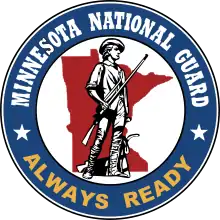Seal of Minnesota
The Great Seal of the State of Minnesota is the state seal of the U.S. state of Minnesota. Originally adopted in 1858, it has undergone several alterations since then, in 1971 and 1983.[2]
| Great Seal of the State of Minnesota | |
|---|---|
 | |
| Versions | |
.jpg.webp) Historical coat of arms (illustrated, 1876) | |
| Armiger | State of Minnesota |
| Adopted | May 10, 1983[1] |
| Motto | L'Étoile du Nord (English: The Star of the North) |
| Earlier version(s) | .svg.png.webp) |
| Use | Former Minnesotan state seal, used from unknown to 1971. |
Symbolism
A sun on the western horizon is a sunset. The straight horizon line reflects the plains covering much of Minnesota. The native on horseback is riding towards the southwest leaving Minnesota as the pioneer is coming from the east taming the land with his plow. The Indian's horse and spear and the Pioneer's ax, rifle, and plow represent tools of daily life. The native is riding away from the Pioneer symbolizing the displacement that was taking place in Minnesota. The only interaction between the figures is one observing the other ride away. The stump symbolizes the subjugation of the land and the importance of the lumber industry to Minnesota in 1858. The Mississippi River and St. Anthony Falls are depicted in the revised seal to note the importance of these resources in transportation, industry and the settling of the state. The cultivated ground also indicates the subjugation of the land while the plow symbolizes the importance of agriculture in Minnesota and its future. Beyond the falls three pine trees represent the state tree and the three pine regions of the state; the St Croix, Mississippi, and Lake Superior.[3]
In the original version, the Indian is horseback, in native attire, riding away from the settler. While the settler is in the field with his firearm tilling over virgin prairie land. There was tension between some tribes of the Sioux and the settlers. "The Indian's Revenge[4]" by Alexander Berghold, writes about an outbreak of Indian attacks which started much as the scene in the original seal. His 1891 book states that after the attacks, settlers were allowed to kill any Sioux that was found in a settlement and that no settler left their home without their rifle. He goes on to say, "The seal of the State, therefore, seems very appropriate".
Government Seals of Minnesota
 Seal of the Minnesota Department of Transportation
Seal of the Minnesota Department of Transportation Seal of the Minnesota National Guard
Seal of the Minnesota National Guard
See also
References
- Office of the Revisor of Statutes (May 10, 1983). "119". 1.135 STATE SEAL. Laws of Minnesota. State of Minnesota. Archived from the original on March 12, 2014. Retrieved March 12, 2014.
- Minnesota Historical Society. "State Seal" (PDF). State of Minnesota. pp. 21–23. Archived from the original (PDF) on September 5, 2005. Retrieved September 5, 2005.
- "Minnesota Statutes - 1.135 STATE SEAL". Office of the Revisor of Statutes. 1983. Archived from the original on June 9, 2012. Retrieved June 9, 2012.
- Berghold, Alexander; Thomas, P. J. (1891-01-01). The Indians' revenge; or, Days of horror. Some appalling events in the history of the Sioux. San Francisco: P. J. Thomas.
.svg.png.webp)
